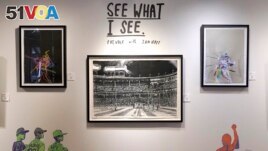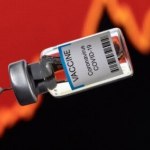22 August 2023
Ian Happ is a professional baseball player for the Chicago Cubs of Major Leagues Baseball in the United States. When he first started playing with the team in 2017, he was looking for pictures to hang in his home.
From that simple desire came an idea and an unlikely partnership with a British artist.
Happ wanted art that showed Wrigley Field, the Cubs ballpark, from a different viewpoint.

The works of British artist Pat Vale titled "See What I See, Pat Vale With Ian Happ." (AP Photo/Charles Rex Arbogast)
Happ said that many fans have been to Wrigley but have never seen what the ballpark looks like from the field. He thought looking up from the field was "such a cool experience" that he wanted to "bring that to more Cubs fans."
He hired the British artist Patrick Vale to create three large drawings of Wrigley from his point of view five years ago.
Instead of having pictures to hang in his home, the partnership led to something quite different.
Happ's view of Wrigley Field became the Through My Eyes project, in which fans can purchase prints. The money goes toward Happ's charity. The drawings by Vale became See What I See, an exhibit at Chicago's Gallery Victor. The show is open through August 26.
All this started with Happ simply looking for artwork.
A college teammate at the University of Cincinnati had become an architect in New York. That teammate gave Happ the names of several artists. One was Vale.
Happ noticed the level of detail in Vale's drawings of cities. After talking with Vale, Happ got the idea to bring Vale to Chicago and draw Wrigley Field from a viewpoint few fans get to experience. The drawings would be from a player's point of view looking out onto the field and into the stands of the famous ballpark.
Happ brought Vale to Chicago in September of 2018 and showed him around Wrigley. Vale knew little about the sport of baseball. But he understood the connection fans have with Wrigley.
"I understand when people talk about baseball and their connections to family and family stories and childhood," said Vale, who lives in New York. "It's the same for me with cricket. I can remember summers in the garden with grandpa and listening to the radio."
Happ had to explain to Vale the importance of the 400 feet sign in center field and the famous manual scoreboard and ivy. He had to teach him the correct positioning of the players. Happ also explained what it feels like standing in the field under the bright lights with a loud crowd.
Vale took pictures and used them to help him create drawings in great detail. He would send rough drawings to Happ, who would mark them up in red ink, like a teacher, with suggestions.
The drawings are mostly in black and white. They show everything from the faces of the fans and the people selling drinks to the numbers and pictures on the video screen. They show a celebration from the view of someone looking down the left-field line. And there is the view from the dugout looking toward third base and right field as the pitcher throws with the bright lights shining.
"He was talking about very specific moments," Vale said of Happ. "The scoreboard needs to feel like the scoreboard, right? I had to respect it and the place."
I'm Ashley Thompson.
Dan Novak adapted this story for VOA Learning English based on reporting by The Associated Press.
_____
Words in This Story
cool — adj. very fashionable, stylish, or appealing in a way that is generally approved of especially by young people
charity — n. the act of giving money, food, or other kinds of help to people who are poor, sick, etc.
exhibit — n. to make available for people to see
teammate — n. a person who is on the same team as someone else
architect — n. a person who designs buildings
stands — n. the rows of seats in a stadium that people sit in when they are watching a sports event, concert, etc.
manual — adj. doing or involving hard physical work
ivy — n. a plant that has long stems and that often grows on the outsides of buildings
dugout — n. a low shelter that faces a baseball field and contains the bench where the players and coaches of a team sit













